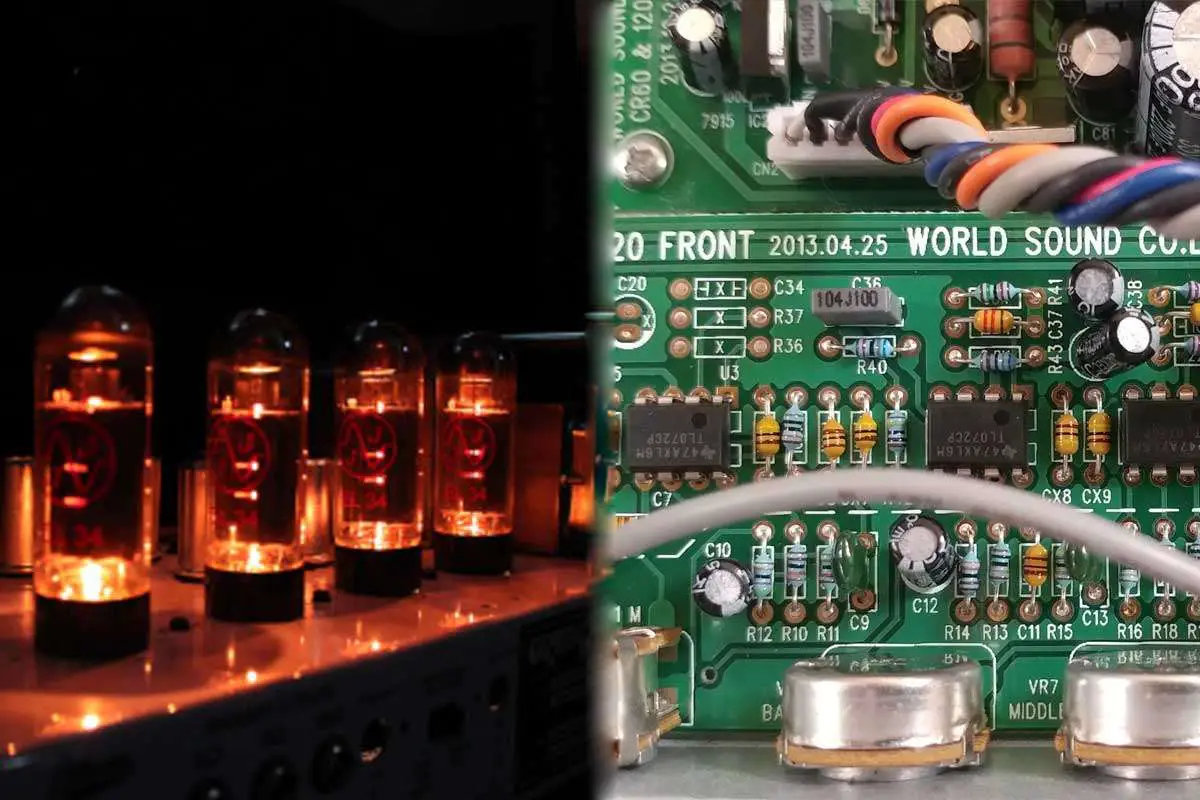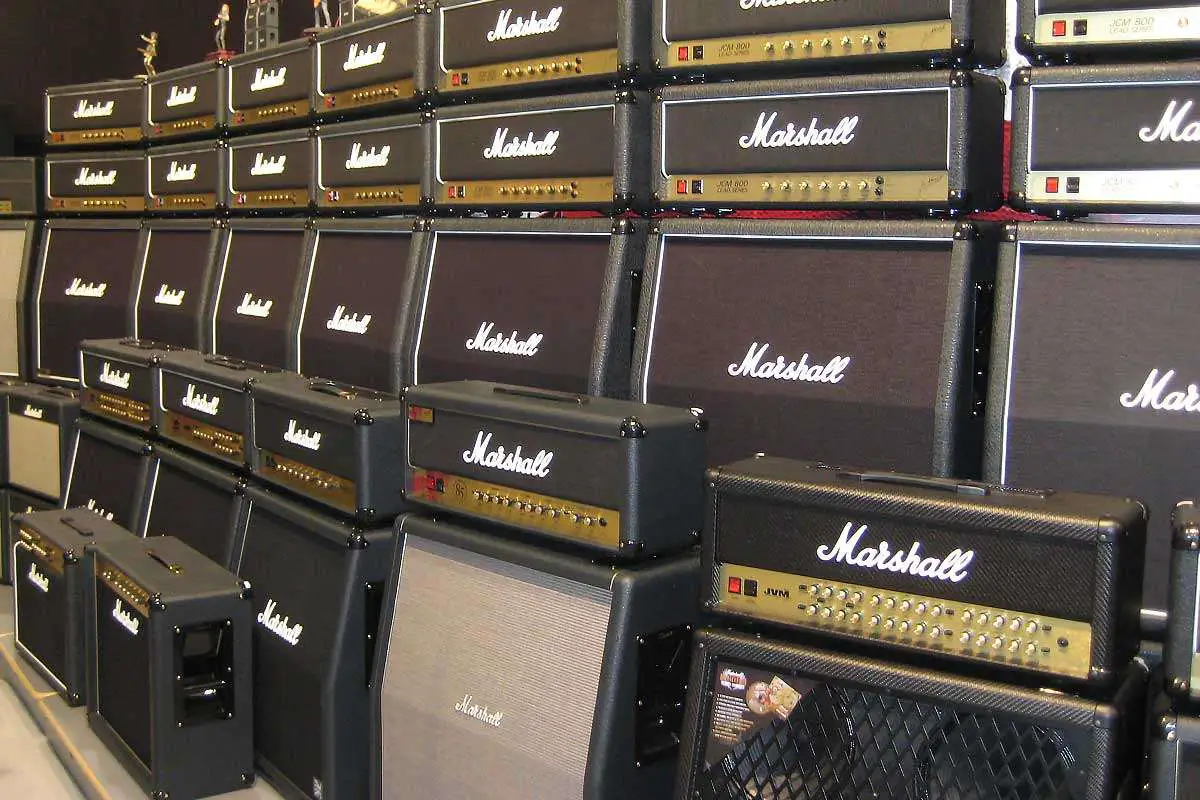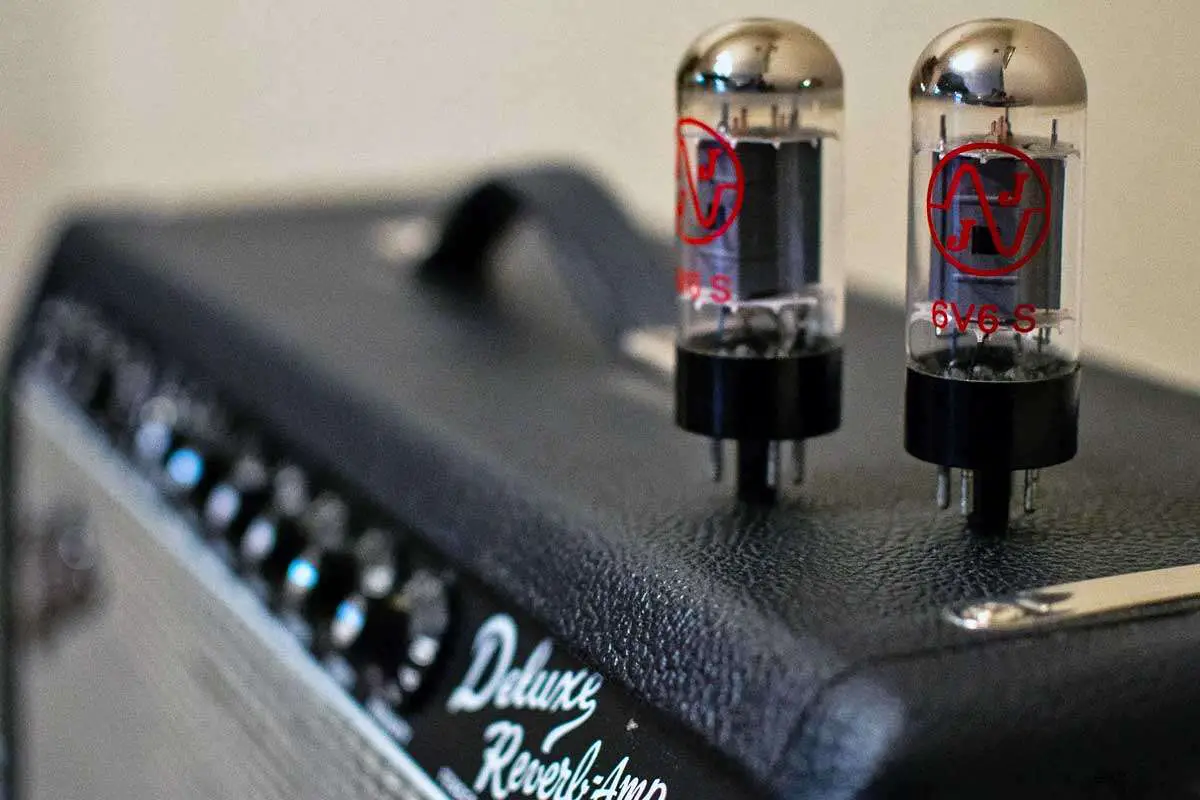In the world of electric guitars, the debate between choosing a tube amp vs solid state is as classic as the instruments themselves. You might be considering the warm, rich harmonics of a tube amp that many guitar enthusiasts swear by, or perhaps the reliability and crisp sound of a solid-state amp align more with your musical preferences. Both types of amplifiers have their distinctive characteristics, which define and influence the sound that ultimately flows from your guitar.
Tube amps are known for their natural overdrive and tonal warmth, which cannot be easily replicated. This quality is due to the nonlinearities in the vacuum tubes or “valves” that amplify the electric signals from your guitar. The complex interactions within these tubes generate harmonics that can give your music a fuller and more dynamic response. If you’re aiming for that classic rock sound, a tube amplifier might be just what you’re looking for.
On the other hand, solid-state amps utilize transistors to amplify the signal and are generally more consistent and durable than their tube counterparts. You might appreciate these amps for their clear tone and lower maintenance requirements. Solid-state technology offers a level of precision and clarity that can be particularly useful in genres that demand crisp and articulate sound reproduction. The choice between tube and solid-state ultimately depends on your personal taste and the specific sound you’re aiming to capture in your music.

Fundamentals of Sound Amplification
To understand how your guitar’s sound is shaped and boosted, it’s vital to grasp the intricacies of your amplifier. The way an amplifier processes and amplifies the signal directly impacts the tone and feel of the output.
Tube Amp Basics
Tube amps, known for their warm, rich harmonics, rely on vacuum tubes to amplify the signal. Your guitar’s sound waves are turned into an electrical signal, driven through preamp tubes for initial amplification, and then through power tubes which magnify the signal enough to drive the speakers. The inherent non-linearity of vacuum tubes contributes to a pleasing harmonic distortion, which is often described as “warm” or “full”.
Solid-State Amp Basics
In contrast, solid-state amps employ transistors and semiconductors on a circuit board to amplify the signal. They offer a cleaner, crisper sound and are known for their durability and reliability. They’re also lighter and generally more affordable than tube amps. Your guitar signal is processed through circuits, without the harmonic distortion mainly associated with tubes, resulting in a more precise representation of your guitar’s tone.
Hybrid and Modeling Amps
Hybrid amps combine both tube and solid-state technologies, usually incorporating a tube preamp with a solid-state power amp, harnessing the tonal warmth of tubes and the reliability and power efficiency of transistors. Modeling amps use digital processors and modeling technology to simulate the sound of various amps and effects. They provide a versatile range of tones and presets, making them a practical solution for players who need a broad palette of sounds.
Related: A Guide To Guitar Amp Types
Design and Technical Aspects
As you explore the world of amplifiers, understanding the design and technical specifications is crucial. These elements dictate not only the sound quality but also the practical aspects of using and maintaining your amplifier.
Circuit Architecture
In the realm of analog amplifiers, tube amps rely on vacuum tubes which include a cathode and filament for their operation. These elements are integral in shaping the amplifier’s dynamic response and tonal characteristics. Solid state amplifiers, on the other hand, utilize transistors to amplify the signal. This difference in architecture leads to a notable variance in sound output: tube amps are often lauded for their warm, rich harmonics, while solid state amps are known for their clarity and precision.
Maintenance and Reliability
When considering maintenance and reliability, it’s important to note that solid state amps generally require less upkeep due to the absence of delicate vacuum tubes. They are, therefore, perceived as more reliable over the long term. Tube amps will periodically need replacement tubes and potentially more involved maintenance to ensure optimal performance, affecting their reliability.
Wattage and Power Considerations
Power needs are central to choosing the type of amp. Tube amplifiers typically produce a distinct breakup when pushed, which can be desirable for certain musical styles. They don’t usually need as much wattage as solid state amps to achieve this level of dynamic expression. In terms of wattage ratings, solid state amps frequently offer more clean headroom—this means they can maintain a cleaner tone at higher volumes without distortion, which could be beneficial if you require a consistent sound across a wider dynamic range.
Tonal Quality and Sound Characteristics
When comparing tube amps and solid-state amps, you’ll find that their tonal quality and sound characteristics are distinct—shaped by differing electronic designs and components.
Related: Guitar Amp Settings Guide
Harmonic Distortion and Overdrive
Tube amplifiers, known for their characteristic harmonic distortion, tend to produce a warm sound as they naturally approach overdrive. This is partly due to the natural compression they exhibit which enhances the dynamics of the sound, providing a responsive playing feel. When you push a valve amp harder, it generates even-order harmonics, often perceived as more musical and pleasant to the ear.
Clean Tone and Headroom
Solid-state amplifiers typically deliver a clean tone at higher volumes with more headroom, which means the sound remains undistorted even at loud volumes. On the other hand, a valve amp may offer less headroom but imparts a warm tonal character even at lower levels of gain, providing a rich, full-bodied sound.
Warmth, Dynamics and Responsiveness
Warmth, dynamics, and responsiveness are terms closely associated with tube amps. The inherent tonal characteristics of valve circuits contribute to a sound that’s dynamic and rich—a quality often described as “alive.” The responsiveness refers to how well the amp reacts to your touch, picking dynamics, and the nuances of your playstyle, allowing you to influence the tonal outcome through your technique.
In your journey through sound, remember that these characteristics can shape not only what you hear but how you connect with your instrument.
Considerations for Musicians
When choosing between tube amplifiers and solid-state amplifiers, you’ll want to consider how the nuances of each align with your musical genre, performance needs, and recording practices.
Genres and Styles
If you’re a guitar player heavily steeped in the blues or rock genres, you might lean towards a tube amplifier for its warm, rich harmonics and dynamic response. Tube amplifiers like the Fender Princeton are renowned for their distinct overdriven tones, crucial for blues, where the expression in every note counts. Conversely, if you prefer more pristine, consistent tones or dabble in genres that require crystal clarity, solid-state amplifiers could be your ally, offering reliable performance without the harmonic complexity of tubes.
- Tube Amps: Preferred for genres like blues and rock.
- Solid-State Amps: Ideal for genres requiring consistent, clear sound.
Performance and Stage Use
When it comes to live performance, your choice of amplifier can greatly impact your stage presence. If you’re a guitarist who revels in the power and volume of an electric guitar, tube amps are known for their excellent amplitude and natural compression at higher volumes, which can provide that extra punch. Solid-state amplifiers often incorporate presets and emulation features, giving you a variety of tones at your fingertips. They generally offer more portability too, which is a significant consideration if you tour frequently.
- Tube Amps: Better for natural overdrive and loud settings.
- Solid-State Amps: More presets, lighter, and often more portable.
Recording and Home Practice
In the studio or during home practice sessions, the nuances of your amplifier become even more noticeable. Tube amps can introduce a desirable warmth and complexity to your recordings, but they may also require attenuation to manage volume. Solid-state amps, on the other hand, often come with a headphone output for silent practice, and their consistent sound can be an advantage when capturing multiple takes. The emulation capabilities of many solid-state amps can also mimic various cabinet and mic setups without the need for extensive equipment.
- Tube Amps: Offer warmth ideal for recordings; may need volume management.
- Solid-State Amps: Consistent sound; convenient for silent practice and straightforward recording.
Brands and Models
When exploring the realms of guitar amplification, you’ll encounter a wide array of choices. The brands and models you select can significantly influence your sound, whether you’re aiming for the warm, rich tones of tube amps or the reliability and clarity of solid-state amplifiers.

Iconic Tube Amp Brands
Tube amps are renowned for their warm, natural overdrive properties. Brands like Fender and Marshall have set the standard in the industry with legendary models that utilize 12AX7 preamp tubes for their distinct sound. For instance, Fender’s Twin Reverb employs 6L6 tubes to generate glassy cleans and rich harmonics. Marshall, known for its powerful output, often uses EL34 tubes in its amps to achieve that classic British crunch many guitarists aspire to.
Popular Solid-State Choices
Solid-state amps use transistors and semiconductors for amplification, which makes them more reliable and maintenance-free compared to tube models. They also offer a cleaner sound. Popular choices include models from brands like Roland and Orange. Many of these amps are lightweight and provide a consistent sound at any volume, making them a versatile option for playing live or practicing at home.
Economic Factors
When considering the economic implications of a tube amp versus solid state amp, you should focus on the overall cost of ownership, potential resale value, longevity of the unit, as well as weight and portability which contribute to their practicality.

Cost of Ownership
Your upfront spending on a tube amplifier is typically higher than for a solid-state amplifier. However, this investment does not stop at the initial purchase; tube amps require regular maintenance due to their vacuum tubes. These components need to be replaced periodically, which adds additional cost. Solid-state amplifiers, on the other hand, are often seen as more affordable and less demanding in terms of maintenance—making them a cost-effective solution over time.
- Initial cost: High for tube amps; lower for solid-state amps
- Maintenance costs: Regular for tube amps; minimal for solid-state amps
Resale Value and Longevity
The economic advantage of vacuum tubes can be seen in their resale value due to their longevity when well maintained. Tube amps often have a niche market that values them for their unique sound qualities. In contrast, solid-state amps, while reliable, do not typically retain their value as long as tube amps because of the faster pace of technological advancements in the solid-state domain.
- Resale value: Higher for tube amps; lower for solid-state amps
- Longevity: Decades for tube amps; shorter for solid-state amps
Weight and Portability
If your priority is portability, solid-state amplifiers are more suitable due to their lighter weight and less fragile components. They can endure the rigors of travel with less risk of damage. Tube amps are heavier and more delicate, which may contribute to higher transportation costs and a need for careful handling.
- Weight: Heavy for tube amps; light for solid-state amps
- Portability: Low for tube amps; high for solid-state amps
Tube Amp vs Solid State: Pros and Cons
In considering tube amps versus solid-state amps, you’ll encounter distinct advantages and disadvantages in terms of sound quality, maintenance, reliability, and practicality. Let’s examine these aspects to help you determine which amplifier suits your needs.
Tube Amp Advantages and Drawbacks
Advantages:
- Warm Sound: Tube amps are praised for their warm, rich sound that many musicians and audiophiles seek. The natural overdrive of vacuum tubes contributes to a beloved harmonic distortion.
- Desirable Dynamics: You might appreciate the dynamic response of tube amps that can enhance the expressiveness of your playing.
Drawbacks:
- Maintenance: Due to their design, tube amps require periodic replacement of the vacuum tubes, adding to their maintenance needs.
- Delicacy: Tube amps can be fragile. You need to handle them with care to avoid damaging the sensitive vacuum tubes inside.
Solid-State Amp Benefits and Limitations
Benefits:
- Reliability: Solid-state amps are known for their reliability and durability. They are less susceptible to wear over time compared to tube amps.
- Practicality: With no tubes to replace and a generally sturdy build, solid-state amps require less maintenance and are often more user-friendly for the average consumer.
Limitations:
- Sound Qualities: Some musicians argue that solid-state amps lack the warm sound that tube amps provide, particularly when overdriven.
- Perceived Sterility: Certain listeners feel that the sound from solid-state amps can come across as sterile or less lively compared to the warmth and depth of a tube amp’s tone.
